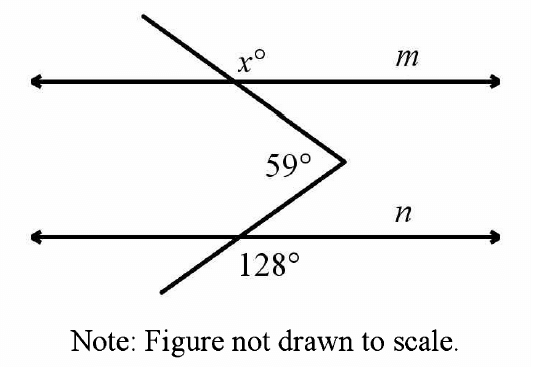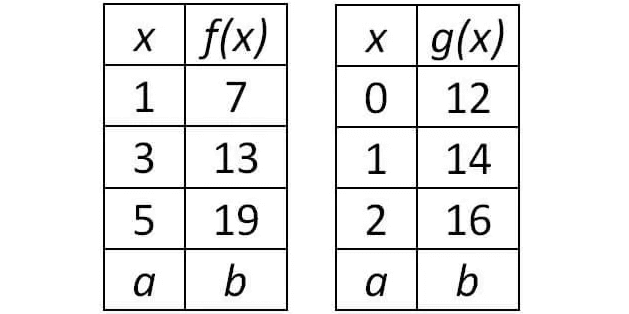FIND THE LINEAR FUNCTION SATISFYING THE GIVEN CONDITIONS
A linear function has the following form
y = f(x) = a + bx
A linear function has one independent variable and one dependent variable.
Independent variable = x and Dependent variable = y.
a is the constant term or the y intercept. It is the value of the dependent variable when x = 0.
b is the coefficient of the independent variable. It is also known as the slope and gives the rate of change of the dependent variable.
To find slope, we use the formula
Slope (b) = (y2-y1)/(x2-x1)
Example Problems
Example 1 :
Write an equation for the linear function f satisfying the conditions. Graph y = f(x).
(i) f(-5) = -1 and f(2) = 4
(ii) f(-4) = 6 and f(-1) = 2
Solution :
Let y = a+bx be the required linear function
y = a+bx ---(1)
By comparing the given question with y = f(x), we know that
when x = -5, y = -1 ==> (-5, -1)
when x = 2, y = 4 ==> (2, 4)
b = (y2-y1)/(x2-x1)
b = (4+1)/(2+5)
b = 5/7
To find a, we may apply any one of the points and value of b in (1).
y = a + (5x/7)
Applying (-5, -1), we get
-1 = a + 5(-5)/7
-1 = a - (25/7)
-7+25 = 7a
18 = 7a
a = 18/7
By applying the value of a and b in (1) we get,
y = (18+5x)/7
So, the required linear function is y = (5x+18)/7.
(ii) f(-4) = 6 and f(-1) = 2
Solution :
Let y = a+bx be the required linear function
y = a+bx ---(1)
By comparing the given question with y = f(x), we know that
when x = -4, y = 6 ==> (-4, 6)
when x = -1, y = 2 ==> (-1, 2)
b = (y2-y1)/(x2-x1)
b = (2-6)/(-1+4)
b = -4/3
To find a, we may apply any one of the points and value of b in (1).
y = a + (-4x/3)
Applying (-4, 6), we get
6 = a-4(-4)/3
6 = a+(16/3)
18 = 3a+16
2 = 3a
a = 2/3
By applying the value of a and b in (1) we get,
y = (2-4x)/3
So, the required linear function is y = (-4x+2)/3
Example 2 :
g(2) = 1 and the graph of g is parallel to the line
6x−3y = 2
Solution :
Since the required line and the given line are parallel, their slopes will be equal.
g(2) = 1 ==> (2, 1)
b = -coefficient of x/coefficient of y
b = -6/(-3)
b = 2
By applying the value of b in the general form of linear function, we get
y = a+2x
The required linear function passes through the point (2, 1).
1 = a+2(2)
1 = a+4
a = -3
y = -3+2x
So, the required linear function is y = 2x-3.
Example 3 :
g(2) = 1 and the graph of g is perpendicular to the line
6x−3y = 2
Solution :
Since the required line and the given line are perpendicular, the product of their slopes will be equal.
g(2) = 1 ==> (2, 1)
b = -coefficient of x/coefficient of y
b = -6/(-3)
b = 2
Required slope = -1/2
By applying the value of b in the general form of linear function, we get
y = a+(-x/2)
The required linear function passes through the point (2, 1).
1 = a-(2/2)
1 = a-1
a = 2
y = 2-(x/2)
y = (4-x)/2
So, the required linear function is y = (-x+4)/2.
Example 4 :
The x and y-intercepts of f are 5 and −1, respectively.
Solution :
y = a+bx ----(1)
By writing x intercept as point, we get (5, 0).
By writing y intercept as point, we get (0, -1).
Slope = (-1-0)/(0-5)
b = 1/5
y = a+(x/5)
The required function is passing through the point (5, 0).
0 = a+(5/5)
a = -1
y = -1+(x/5)
y = (-5+x)/5
Example 5 :
A plumber charges a $60 call out fee and $48 per hour.
a) Copy and complete the table :

b) Name the dependent and independent variables.
c) Find the linear model that connects the variable.
d) Find the cost of a plumbing job that took 6 1/4 hours.
Solution :
Given that, a plumber charges a $60 call out fee and $48 per hour.
Let h be the number of hours he is working. Let C be the total cost.
C = 60 + 48h
a)
|
Hour (h) |
Cost (C) |
|
0 |
When h = 0 C = 60 + 48(0) C = 60 |
|
1 |
When h = 1 C = 60 + 48(1) C = 60 + 48 C = 108 |
|
2 |
When h = 2 C = 60 + 48(2) C = 60 + 96 C = 156 |
|
3 |
When h = 3 C = 60 + 48(3) C = 60 + 144 C = 204 |
|
4 |
When h = 4 C = 60 + 48(4) C = 60 + 192 C = 252 |
b) Number of hours he is working in independent variable and total cost is dependent variable.
c) The required function is C = 60 + 48h
d) Cost of a plumbing job that took 6 1/4 hours :
h = 6.25
Applying the value of h, we get
C = 60 + 48(6.25)
= 60 + 300
= 360
For working 6 1/4 hours, he get $360.
Kindly mail your feedback to v4formath@gmail.com
We always appreciate your feedback.
©All rights reserved. onlinemath4all.com
Recent Articles
-
Quadratic Equation Problems with Solutions
Apr 12, 25 08:21 PM
Quadratic Equation Problems with Solutions -
Digital SAT Math Problems and Solutions (Part - 142)
Apr 11, 25 06:26 PM
Digital SAT Math Problems and Solutions (Part - 142) -
Digital SAT Math Problems and Solutions (Part - 141)
Apr 11, 25 10:38 AM
Digital SAT Math Problems and Solutions (Part - 141)

